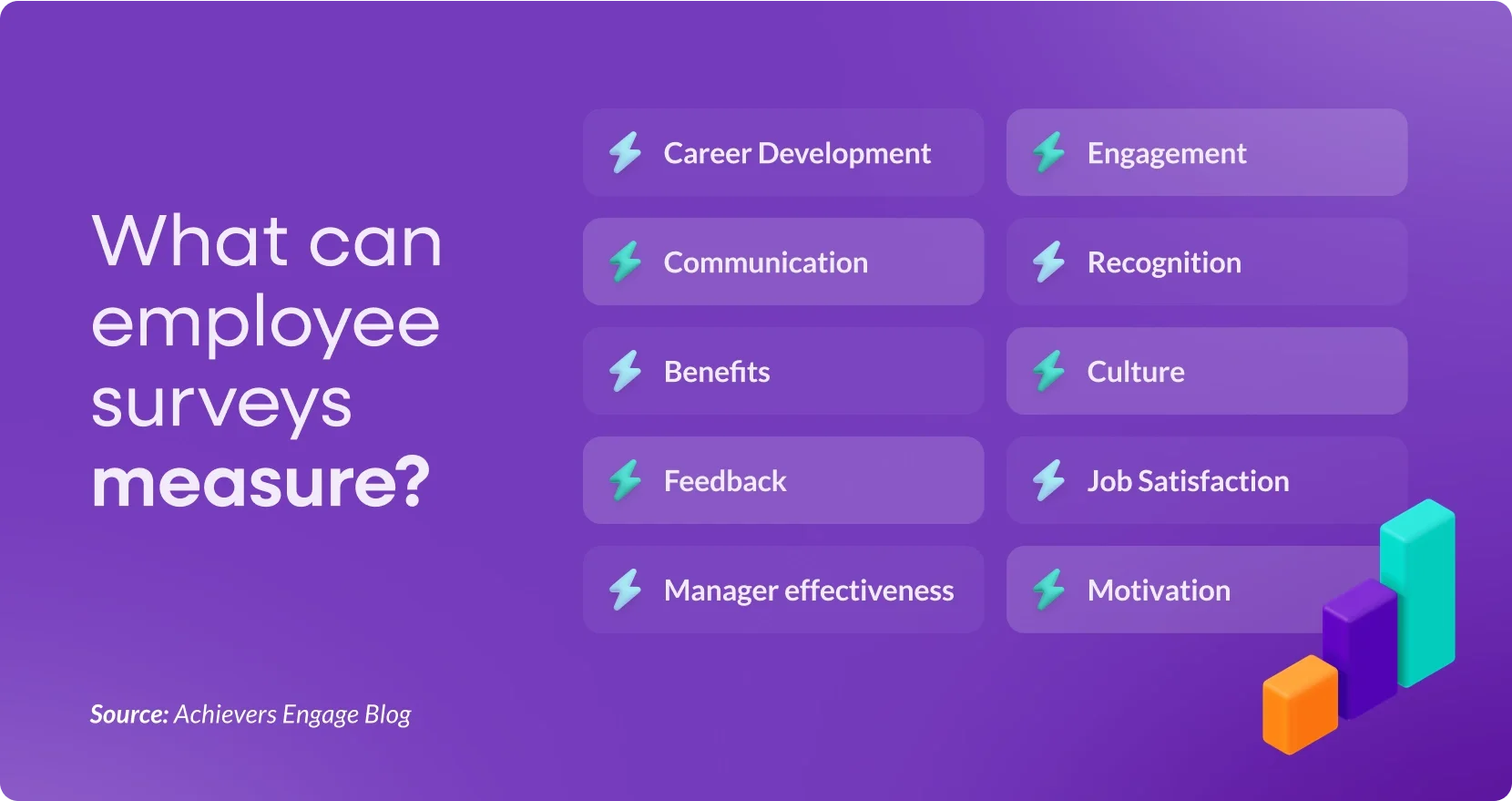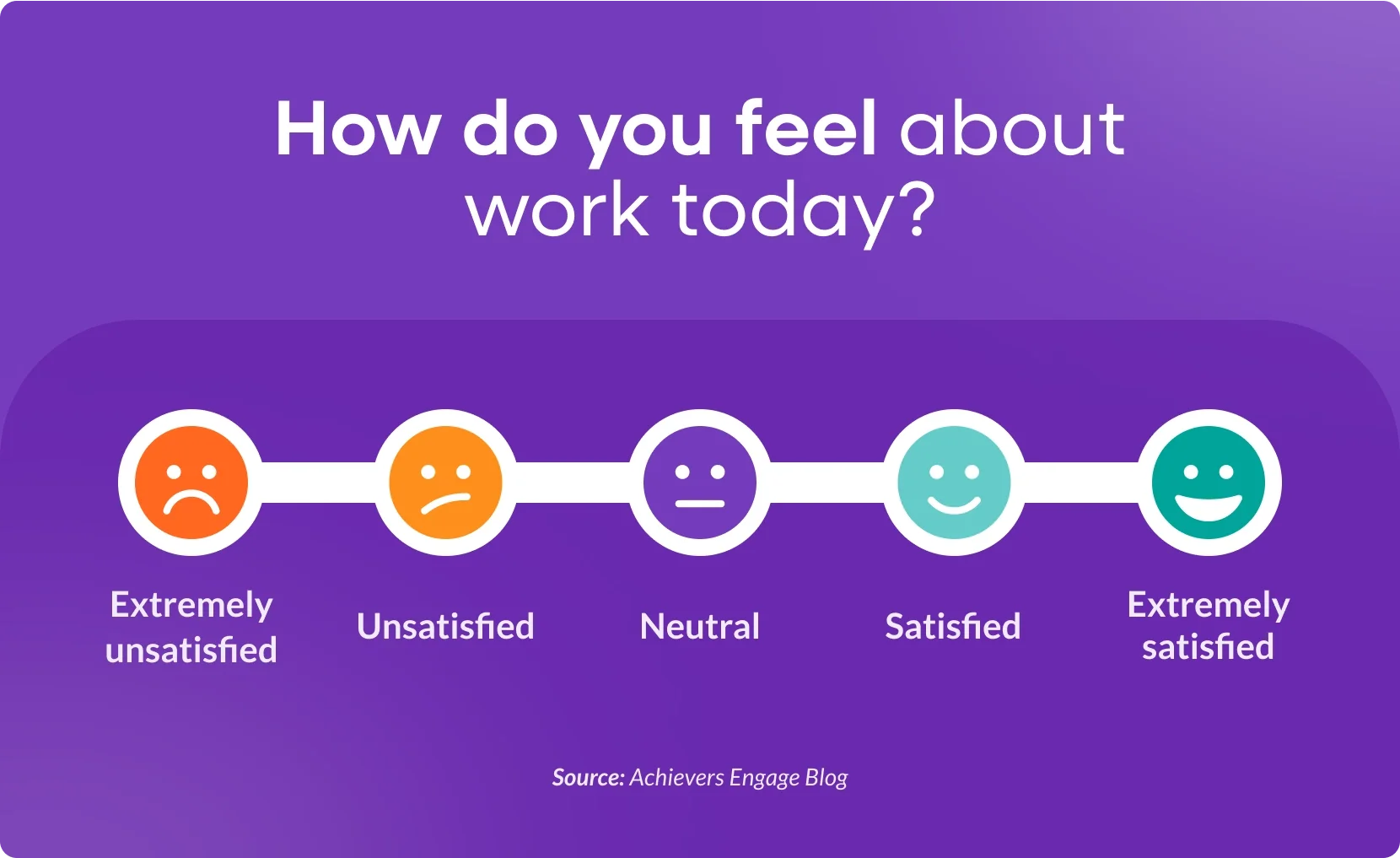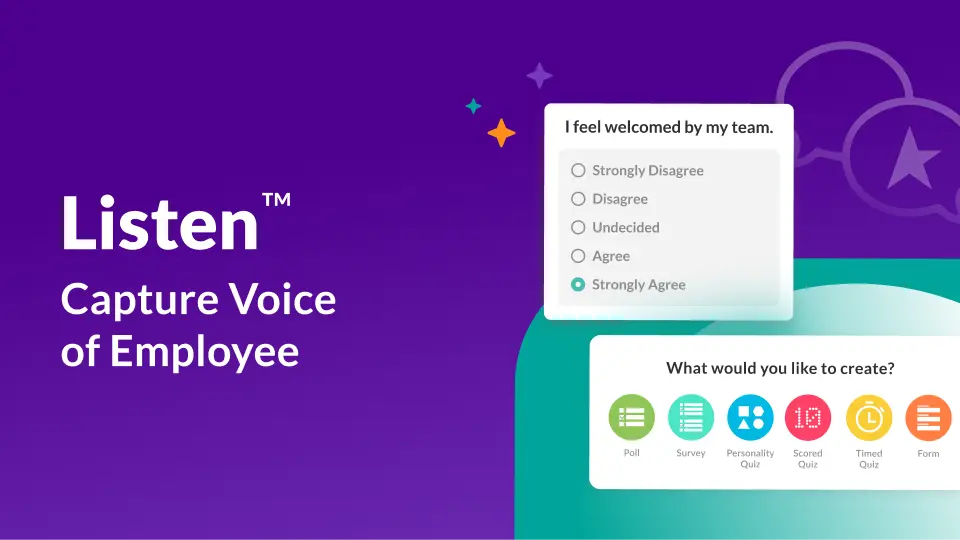Table of contents
Employees want to feel a sense of belonging in the workplace. They want a space to voice their concerns, share their feedback, and be a part of their organization’s growth in a meaningful way. When employees are engaged, that engagement can help drive business results and create a more dynamic, healthier place to work.
In fact, Achievers’ 2024 Engagement and Retention Report found that 72% of employees say they would prefer a job where they feel supported and valued, compared to a job that paid 30% more but where they did not feel like they belonged.
What it comes down to is that employees want their voices to be heard, and surveys are the best way to get honest feedback from your team and improve the employee experience. The need for open communication and transparency in the workplace is growing, and it’s up to business leaders to answer the call.
But before you get started, you need to consider how to best design and manage your organization’s surveys. This guide gives you everything you need to create a winning employee survey process from delivery to action.
What is an employee survey?
Organizations use employee surveys to collect feedback from their employees about various aspects of the workplace. These types of questionnaires are designed to assess employees’ thoughts and feelings about their roles, the company culture, management effectiveness, and other important areas that influence morale and productivity.
Employee surveys are typically sent out periodically or frequently. They provide a structured way for employers to understand how their employees feel about their workplace and identify areas that could be improved in the organization. By understanding the collective voice of their employees, leaders can identify common themes and address issues that may hinder employee satisfaction and retention.
Surveys also help promote transparency and open internal communication between an employer and their employees. This fosters mutual trust and collaboration across all levels of an organization. Ultimately, they serve as a foundation for building a positive work environment that aligns with the goals and aspirations of the employees and the organization alike.

What can employee surveys measure?
An employee survey is a valuable tool that can provide insight into all the major drivers of the employee experience. By combining listening tools with an integrated recognition platform, employers can see first-hand how employees feel about all aspects of the organization — from the recruitment and onboarding process to their role responsibilities and relationships with leadership.
Here are a few of the most important metrics:
Engagement
Engaged employees are an organization’s most valuable resource. According to Gallup, organizations that rank in the top 25% for employee engagement see 23% higher profitability, 81% lower absenteeism, and between 18% and 43% less turnover. That’s why you need to keep tabs on engagement levels in real time using employee surveys and act quickly to prevent disengagement from taking root.
Recognition
Recognition is one of the most powerful tools available to employers that want a happier, more engaging workforce. According to Achievers’ 2024 State of Recognition Report, employees who are recognized on a monthly or more basis report are twice as engaged and productive as those who are recognized quarterly or less. Tracking the success of your organization’s recognition program lets you provide real-time, data-driven results to leadership and maximize the program’s impact.
Culture
A great organizational culture is reflected in the engagement and trust between employees, their peers, and leadership. Measuring every aspect of your organization will help offer a well-rounded view of its strengths and help identify areas of opportunity. If there are problems with one aspect of your company’s culture, it can cause a ripple effect across the board — from buying into your company values to trusting in leadership. By tracking employee sentiment through frequent surveys, you can rest assured that your team members will stay aligned with the culture you want to build.
Job satisfaction
The feeling of belonging is an essential part of the employee experience. When employees don’t feel respected or valued by their employer, they’re more likely to look for opportunities elsewhere. Implementing an employee survey regularly is a great way to make sure you’re hearing your people’s concerns and addressing them with actionable steps. But a questionnaire doesn’t just highlight the opportunities for improvement in your organization. They’re also a valuable way to see what’s working well and the practices or behaviors that you should continue to demonstrate.
Motivation
When employees feel listened to and respected for their feedback, they’re more likely to advocate for your organization and be passionate about working towards company goals. Surveys are a beneficial tool that can offer targeted insights into areas within the company that affect employee motivation. Maybe there’s a lack of professional development opportunities available or employees are too burnt out to feel motivated to do their best work. With these insights, employers can see where they’re falling short and make quick, effective changes. When these concerns are taken seriously by a leader, employees feel empowered to be active team players.
Career development
Your organization is always evolving and innovating, and it’s important that your employees feel like they’re a part of that growth. When you invest in employee development, you not only help your team develop new skills, but you also create a more agile and motivated workplace. The key is to provide opportunities to your employees to learn more about their career aspirations. An employee survey offers a channel for individuals in the organization to show where their passions lie and where they see themselves progressing in the company in the long term. Leaders can use these insights to assess areas of opportunity and help nurture those next steps.
Communication
Open and transparent communication is a fundamental part of a successful workplace, no matter the size or industry of the organization. When employees feel honest about their role and how the company runs, they’re more likely to feel like they belong and have a voice. It also promotes a culture where new ideas are welcomed. But it’s not always easy for employees to communicate with their employers face-to-face. A regular pulse survey helps keep the lines of internal communication open and ensure your team feels heard without added pressure.
Benefits
Employee benefits are an essential part of employee retention and engagement. In fact, a study from the Society for Human Resource Management, via Forbes, found that 60% of employees said benefits were a key factor in deciding whether to stay with their current employer.
Through employee surveys, employers can assess the competitiveness of their benefits package. Surveys can help organizations understand how their employees feel about their coverage and where they believe improvements can be made.
Feedback
When it comes to employee feedback, do you know how your employees truly feel about their role or how your organization runs? The reality is that identifying where you might be falling short can be a challenge; especially if your only method for feedback is in-person employer check-ins or team meetings. Employees may not always feel comfortable going to you directly with their concerns, and that’s okay.
An online employee survey offers individuals an opportunity to speak more freely about their concerns and roadblocks they’re experiencing. Employers can then use that data to make regular changes and adjustments based on the feedback they receive.
Manager effectiveness
Management isn’t just about overseeing projects and setting deadlines. A great manager is passionate about building a culture of trust, transparency, and respect. The most effective way to know if you’re on the right track is to listen to the people you manage and hear their concerns. An employee survey offers a safe space for your team members to share how they really feel about your leadership style, the good and the bad. These insights can then help you tailor your approach to be more aligned with the culture you’re trying to build.
Why are employee surveys a good idea?
Employee surveys act as an essential form of internal communication between employees and management. They allow individuals to share their wins, their concerns, and suggestions. By using employee surveys as a key recognition tool, organizations can identify areas where they excel and areas that need improvement, promoting an environment of continuous growth.
These surveys are essential in recognizing trends in employee engagement, which directly leads to increased productivity, reduced turnover rates, and improved organizational performance. Plus, conducting regular surveys communicated to employees that their opinions are valued, which can improve morale and motivation. This process not only uncovers hidden issues before they become critical but also opens the door to innovative solutions that align with the company’s goals and employees’ aspirations, building a more resilient and connected workplace culture.
How to deliver employee surveys
After deciding to incorporate employee surveys into your organization, the next decision you have to make — and the most important — is how you’re going to create and deliver them. Sure, you could look to outside resources to help you achieve your goals, but they aren’t going to be able to provide the results you need to collect authentic, transparent employee data. Instead, you’ll spend time you don’t have waiting for results when you could be taking action instead.
The most effective way to stay connected to your employees, from the onboarding process and beyond, is by building a recognition platform within your organization. Having a comprehensive employee survey platform at your fingertips gives you the freedom and flexibility to reach out to your employees on a regular basis.
Through a combination of pulse surveys and an always-on feedback channel for employees to take advantage of, modern survey solutions let you gather feedback instantly, identify and track trends, and nip problems in the bud. An integrated listening platform is your ticket to understanding what makes your employees tick and learning where your organization has the most room for improvement.
Designing employee surveys
When designed thoughtfully and with intention, employee surveys can provide valuable results for an organization. Below are some guidelines for designing employee surveys that you can put into action yourself or see firsthand by building your own engagement platform.

Use the Likert scale
The easier you make answering your questionnaire, the more employees will respond. When it comes to turning opinions into tangible data, there’s nothing more straightforward than the Likert scale — a five-point scale that ranges from “strongly disagree” to “strongly agree.” It’s a simple way to produce data that’s easily measurable and provides more context than generic yes or no, true or false questions. You can even use visual representations of each part of the scale so employees can quickly identify which answer best aligns with their feelings.
Include some open-ended questions
In addition to true or false-style questions and the Likert scale, include some questions that are open-ended and allow employees to express what they feel in their own words. These might touch on areas the employee would like to see addressed in future surveys or ways the team member’s experience could be improved. You can provide the option to leave comments on other questions, which often provide useful context when analyzing survey results.
Ask short questions aligned with your goals
Regardless of how you format your questions, keep them to the point and align them with the goals of your survey. If you’re trying to measure the success of your recognition program, ask questions connected to the KPIs you measure success by. If you’ve noticed that burnout is running rampant in your company, focus on all the factors that can contribute to it. Lean surveys that get directly to what you want to know at the moment are more digestible for employees and more useful for your company.
Keep it anonymous
Anonymous surveys are a must. If your employees know that leaders and HR will be able to connect them to their feedback, they’re not going to tell them things they don’t want to hear. With the security anonymity provides, employees can express themselves honestly and directly address their concerns without fear of retaliation. Practicing anonymity also includes giving employees a private place to complete surveys, so they know no one will be checking on their responses during the process.
Follow up automatically
Taking action on survey results is essential, but even the quickest response is going to take some time to implement. Your employees need to know that you’re listening in the meantime. That’s why an always-on feedback channel through an innovative resource like Allie, Achievers’ HR chatbot is an integral part of any employee survey solution.
This automated tool can follow up with employees using friendly, simple questions to explore issues uncovered by the survey immediately. Employees then know that the organization is actively engaged with the issues that matter to them, and the company gets added data to analyze.
Questions to ask
Still wondering what a good employee survey looks like? These questions can help offer useful insights, phrased as statements employees can rank using the Likert scale:
- Recognition: You’re recognized for your contributions to the company.
- Culture: Our company has a healthy culture.
- Morale: You enjoy coming to work each day.
- Values: You’re inspired by our company’s mission and values.
- Career advancement: There’s a clear path for career growth available at our company.
- Leadership: Your manager is invested in the success of your team.
- Feedback: You feel comfortable providing honest feedback.
- Health and wellness: You have a healthy work-life balance.
- Team: You have a collaborative relationship with fellow team members.
- Open-ended: If you could change one thing about this organization, what would it be, and why?
Responding to employee surveys
If you don’t act on issues revealed by employee surveys, you’ll have wasted all the time and effort you spent on designing and delivering them. But analyzing survey data and deciding on how to respond is anything but simple. Here’s how you can take actionable steps in the right direction.
Analyze
You can’t afford to spend weeks or months analyzing survey results. You need a survey platform with robust tools for digging into the data, helping you understand key findings instantly:
- Heat maps: These are grids that let you visually identify areas where your organization is doing well (highlights) and areas where it needs to improve (hotspots). You can use heat maps to uncover actionable insights as soon as a survey round opens.
- Establishing benchmarks: Whether based on industry-standard performance or against other teams or business units — is a great way to show areas where certain groups are falling behind. Tracking your progress against benchmarks over time in your platform lets you easily measure progress towards your goals as well.
- Dashboards: These provide information on all your KPIs in one place, and they allow you to access other analytics tools and generate reports using an intuitive interface. You can even tailor them to suit various managers’ unique needs.
- Comments: These are a reliable source of contextual information, but sifting through them poses a challenge. Look for a solution that lets you sort through them by category and efficiently navigate between them.
Above all, ensure that managers play the leading role in reviewing the results of your survey. They’re the ones who can act on a team level to implement changes. HR professionals should support them, giving them the tools and guidance they need to successfully navigate the survey process.
Act
Choosing a one-size-fits-all response from an action library lets your managers check a box and move on, rather than actively engaging with the unique circumstances they face and taking steps to address them.
Instead, all managers should share survey results with their team, discuss the insights they’ve gained, and then create a collaborative action plan to tackle any issues named. Managers should then work with their team and other parties to carry out next steps, ideally through quick, tangible actions — otherwise known as micro-actions — that can be implemented without hesitation.
The collaborative aspect is critical. Every team member has their own needs and wants, so each should be consulted and given the chance to voice their thoughts on the best way forward. When you empower employees to take ownership of correcting the problems they see in the workplace, they’ll respond with increased engagement and a willingness to do what it takes to build the organization they want to see.
Make employee surveys easy with Achievers
Knowing how your employees feel doesn’t need to be a guessing game. With Achievers Listen, you can gather insights that can help drive meaningful change in your organization. Our all-in-one solution includes a variety of features and benefits you can use to improve engagement and increase retention. With our pulse surveys, regular employee data and feedback is at your fingertips. See the impact Achievers Listen can have on your organization today with our customized recognition platform.



